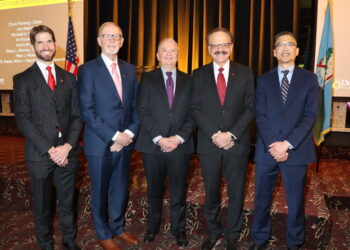OKLAHOMA CITY (OBV) – Many Oklahomans and people across the nation are leaving the workforce due to a lack of viable and affordable childcare options.
Parents struggle each day to maintain a job while ensuring their children receive proper care and supervision. Data shows that many parents have quit their job because they cannot find a nearby or affordable childcare facility to which they can entrust their child’s wellbeing during work hours.
A U.S. Chamber of Commerce 2022 report states that the childcare industry was not spared the business-debilitating ravages of the COVID-19 pandemic. Thousands of childcare facilities closed down amid the pandemic.
“In the last two years, the pandemic has only magnified this issue with 16,000 childcare centers being forced to close their doors, and many providers having to operate at limited capacity,” the U.S. Chamber report states.
There were 920,000 childcare workers across the nation before the pandemic hit. The childcare workforce fell more than 30 percent at the pandemic’s apex and was still 7 percent lower as of 2022, according to the report.
Childcare facilities have been on decline for more than a decade.
The Sooner State had more than 4,000 facilities in 2012; that number shrank to 2,954 by 2021.
“Fifty-five percent of the state of Oklahoma is categorically listed as a childcare desert, which means there are more than three children from birth to age five who need childcare compared to the licensed capacity of childcare in Oklahoma,” said Carrie Williams, executive director of Oklahoma Child Care Resource and Referral.
Many parents say they experience long wait times to get their child into a childcare facility, according to Williams.
“The wait list for childcare can be up to two years for an infant. So, they’re not an infant anymore by the time the parents can obtain childcare,” William said.
The shortage of childcare facilities and workers has had a ripple effect across the workforce. There has been a 6.1 percent decline in workforce labor participation among Oklahoma mothers who have children ranging in age from infant to four years old.
“Often times the parent has to either leave the workforce or make a new work arrangement. It’s even harder if a family has nontraditional hours of care that they need; it’s very difficult to find childcare that operates outside traditional hours of 7 a.m. to 6 p.m.,” Williams said.
Parents nationwide are exiting the workforce because they do not have a childcare option.
A U.S. Chamber of Commerce Foundation study states that 58 percent of working parents reported leaving their job because they could not find viable childcare. Also, 32 percent of women surveyed said having to be home to care for family members made returning to work difficult.

The childcare shortage is not only causing parents to leave their job, it’s also preventing them from returning to work.
“Dropping out of the workforce to care for children greatly disadvantages women, often in the form of lower wages and missed promotions,” the U.S. Chamber report states.
Childcare breakdowns cause states to lose an average of $1 billion in economic activity annually, according to the foundation study. Part of the lost revenue stems from the cost of parents missing work because quality childcare was not available—or unaffordable.
“It has a real economic impact in the state of Oklahoma,” Williams said.
The average cost of childcare in the U.S. ranges from $11,000 to $29,000 annually, according to the U.S. Chamber.
Oklahoma parents who manage to find a childcare facility nearby often have to contend with high childcare costs. Oklahoma is one of the 10 most expensive states for childcare costs, with families having spent 6.9 percent of their income on childcare in 2020.
Businesses are also adversely affected by childcare shortages. Childcare system gaps prevent businesses from fully re-staffing their operations, which leads to closures and operation hour reductions across all industries. The Foundation study states that employee absences and turnover costs employers anywhere from $400 million to $3 billion a year.
The state used funds from childcare desert grants as well as stabilization grants to help Oklahoma childcare centers and incentivize the opening of new centers, according to Williams.
Subsidized childcare aid provided through a federal Childcare Development Fund grant is helping low-income Oklahoma families reenter the workforce. It also aids individuals working in the childcare field.
“It’s a powerful recruitment and retention tool for childcare providers, which helps them increase the capacity they have to care for children,” Williams said.
The state has made a legislative budget request from the Department of Human Services for an additional $30 million in support of subsidized childcare, according to Williams.
“We’ve never been at the childcare level we needed to be at in the state, and the pandemic exacerbated that problem,” Williams said. “We’re hoping the stabilization and childcare desert grants will have an impact a year from now on our capacities to care for children in Oklahoma.”
Also, bills currently in the Oklahoma Legislature aim to help solve the state’s childcare crisis.
The Childcare Receives Investment from Business (CRIB) Act, written by Sen. Jessica Garvin, R-Duncan, and House Bill 2451, written by Rep. Suzanne Schreiber, D-Tulsa, seek to help parents afford childcare by providing tax credits to employers who either expand or establish childcare facilities or provide financial assistance to employees for childcare. HB 2451 also provides a tax credit to childcare workers to address the childcare center and worker shortage.
“Addressing access to childcare in this way will ensure the growth and sustainability of this important sector of Oklahoma’s economy, and at the same time, it sends a message to Oklahoma families that we are working for common sense solutions to the real problems they face staying in the workforce.” Schreiber said. “Often the biggest barrier for Oklahomans to stay in the workforce is a lack of consistent and affordable childcare. Breaking down those barriers serves our employers too. When we strengthen the childcare industry, we strengthen all industries.”

















